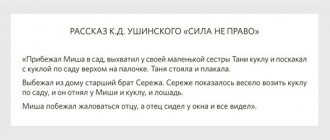Games in the pool for senior and preparatory groups
Seine
The goal of the game is to help you get comfortable with water resistance.
Description. The players (fish) are located in a limited space. Two fishermen, holding hands, at the teacher’s signal, run after the fish, trying to surround it. Each fish caught is included in the chain of fishermen. This is how the net is gradually formed. The game ends when all the fish have been caught.
Rules. You can’t catch fish with a torn net, grab your hands,
torso.
Methodical instructions. The drivers are appointed by the teacher. The last one caught is declared the fastest fish.
Carousels
Objective of the game: to promote mastery of water, walking and running in water.
Description. Holding hands, the children form a circle. At a signal, they begin to move in a circle, gradually speeding up their pace. While moving in a circle, the players say in chorus:
Barely - barely, barely - barely
The carousels are spinning
And then, then, then -
Everybody run, run, run!
After which the children run in a circle (1 - 2 circles). Then the teacher says:
“Hush, hush, don’t rush, stop the carousel.”
Children gradually slow down and say
So the game is over. Stop – once and twice” they stop. The game is repeated with movement in the opposite direction.
Rules. You can’t let go of your hands and fall into the water.
Methodical instructions. The depth of water can be increased by explaining by example that the resistance of water during movement increases the more, the more of the surface of the body is under water.
Crucians and carps (
Option 2)
The goal of the game is to teach children to move freely in the water.
Description. The teacher divides the players into two groups. Children stand in lines with their backs to each other, and then squat. The distance between the ranks is 0.5 - 1 meter. For each line, the direction in which to run is planned in advance. One line is crucian carp, the other is carp.
The teacher pronounces these words in any order. The named team (line) immediately rises and runs in the indicated direction.
The children of the other team get up, turn around and catch up with those running away, trying to touch them with their hands. The child touched by the hand stops. At the teacher’s signal, everyone stops, returns to their original places, and the game starts all over again.
Rules. While in a line, you cannot turn back. While jogging, you should not push each other. You cannot continue running after the stop signal.
Methodical instructions. The game can be played in waist-deep water. It is better to build ranks according to height so that their right flanks are opposite each other. The same command can sometimes be called twice in a row. The teacher should pronounce the words “Crucian carp” and “Carp” slowly, drawlingly, stretching out the first syllables of the word and quickly pronouncing the last.
We are funny guys
Objective of the game: To teach children to move energetically in the water in different directions.
Description. Children walk in a circle, in the middle there is a driver, appointed or chosen by the children. The children recite the text in chorus:
We are funny guys
We love to swim and dive.
Well, try to catch up with us!
One, two, three - catch it!
After the word “Catch!” the children run away, and the driver catches up. The game ends when he catches up with 2 - 3 - 4 players. When the game is repeated, a new driver is selected.
Rules. You can’t run away before “Catch!” is said. When moving in a circle, children must maintain order, do not pull, do not break the circle, and do not push each other.
Methodical instructions. The teacher helps you choose a driver. He should not be chosen from the children who came first, so as not to give reasons for children to quickly become drivers.
Kayaks
The purpose of the game: to teach to overcome water resistance, to practice performing rowing movements with your hands.
Description. Children stand at one side of the pool, slightly tilting their torso forward. These are kayaks. At a signal, children walk or run to the opposite side of the pool, helping themselves with rowing movements, like oars when swimming in a kayak. The hand should be straightened, with the palm of the child the children scoop up the water and push off from it, moving forward
Rules. Start moving and stop at the teacher’s signal. You cannot rush and interfere with other children completing the task.
Methodical instructions. The teacher monitors the correct execution of the children’s actions, notes which kayak is moving faster, and whose oar stroke is longer. When repeating, you can add a complication to the game: invite the children to swim in a kayak backwards. At the same time, turn your palms in the opposite direction.
Crucian carp and pike
Objective of the game: exercise movement in water.
Description. Children form a circle and hold hands. Carp and pike are selected. They stand in the center of the circle. Children say:
Karasik, crucian carp, hold on,
Don't get caught by a pike!
After these words, the crucian carp swims away, and the pike catches up with it.
The crucian carp can swim outside the circle, children do not stop it. The spruce pike is trying to slip out of the circle. The children give up, not letting her go.
Rules. Start moving only after the words “don’t get caught!” You cannot open your hands and grab the pike.
Methodical instructions. When choosing crucian carp and pike, the teacher makes sure that the pair is paired with children of equal strength and skills
Who swims how?
Objective of the game: to train children in different types of movement in water.
Description. Children are shown how different animals move in water: crocodile, crayfish, crab, frog, penguin, dolphin. Then, at the teacher’s signal, the children depict the named animals.
Crocodile - lie down on the water, rest your hands on the bottom, stretch out your legs; moving your hands along the bottom, move forward.
Cancer – move backwards in the same position.
Crab - in the same position, move to the right to the left.
Frog - from a crouching position, jump out of the water and crouch again.
Penguin - move around the pool, swaying from side to side, pressing your arms to your body.
Dolphin - jump out of the water as high as possible from a crouching position.
Rules. Complete tasks when given a signal by the teacher, and do not disturb your comrades.
Methodical instructions. The game can be played provided that all children know the methods of movement of different animals. At first, no more than three tasks should be given. Gradually the number of tasks can be increased.
(Games involving immersion in water with your head)
Sea battle
The goal of the game is to teach children not to be afraid of splashes and to act in concert.
Description. At waist-deep depth, children stand facing each other in two ranks, the distance between which is 1.5 - 2 m. At the teacher’s signal, the children begin to splash water at the “enemy,” trying to force him to retreat. The more persistent team wins, the one that does not run away and maintains the original order. Repeat the game 3 – 4 times.
Rules. You cannot touch players with your hands, turn your back, or run away.
Methodical instructions. When dividing children into teams, you need to take into account their growth and preparedness. Ensure compliance with the rules.
Hunters and ducks
The goal of the game is to practice immersing yourself in water with your head.
Description. Two hunters are selected. The rest of the children are ducks. The hunters stand on both sides of the pool, each of them has a ball. Ducks swim in different directions around the pool. At the signal “Hunters!” The ducks must dive under the water to prevent the hunters from hitting them with balls.
If one of the children did not have time to hide and is hit with a ball, he must leave the game for a while.
Rules. Hunters should not throw balls at children's heads. You can start throwing the ball only after the signal “Hunters!” and without leaving the spot.
Methodical instructions. The hunters switch places after each of them hits a certain number of ducks with the ball.
Pump
Objective of the game: To teach children to dive headfirst into water several times in a row.
Description. Children stand in pairs, holding hands, facing each other. Taking turns squatting, they plunge headlong into the water. Each of the players is immersed in water 4 - 5 times. The game is repeated 3 times.
Rules. You must not let go of your hands and wipe your face, brushing away the water, after each dip.
Methodical instructions. The playing pairs are positioned sideways to
to the teacher.
Fishing rod
The purpose of the game: to train children to dive into water with their heads.
Description. Children form a circle, standing at arm's length from each other, turning to face the center. The teacher stands in the center. He has a rope in his hands, with an inflatable toy attached to the end of it. The length of the rope is equal to the radius of the circle. The teacher rotates the rope so that the toy
moved in a circle at a height of 10–30 cm above the water. Children should avoid touching the toy by diving underwater when it approaches.
Rules. You cannot hide before the toy approaches.
Methodical instructions. First, you should rotate the rope with the toy slightly above the children's heads. When children learn to safely dive into the water, the height can be reduced.
(Games with exhalation into water)
Frisky ball (in a shallow place)
The goal of the game is to promote mastery of long, gradual exhalation.
Description. The players stand in one line at arm's length from each other. Everyone has a ball or tennis ball. Having taken the position of the support lying in front, the children place it on the surface of the water in line with the mouth. Inhaling, they blow on the ball, trying to drive it as far away from themselves as possible. Then they follow the ball along the bottom on their hands, inhaling and exhaling repeatedly. At the teacher’s command, everyone remains in their place and stops blowing on the ball. It turns out whose ball floated the farthest - this is the “fastest ball”. The game repeats itself.
Rules. You can’t interfere with each other or blow on someone else’s ball.
Methodical instructions. At first, the game can be played without moving forward with your hands behind the ball. In this case, only one exhalation is performed each time. The game can also be played in deep places (chest-deep water). Then the players move after the ball, walking along the bottom.
Swing (water depth up to waist)
Objective of the game: to promote mastery of exhaling into water. Description. Children stand in pairs, holding hands, facing each other. Taking turns squatting, they plunge headlong into the water and exhale into the water. Each player makes 3 - 4 exhalations into the water. Rules. You cannot let go of your hands and hold your comrade under water.
Methodical instructions. The playing pairs sit sideways to the teacher.
(Eye-opening games in water)
Divers
The goal of the game is to teach children to boldly open their eyes in the water and look at objects underwater.
Description. Children stand at the edge of the pool on one side. The teacher scatters rubber (sinking) toys and plastic plates along the bottom of the pool. At a signal, divers dive into the water and try to collect as many items as possible.
Rules. Start completing the task when given a signal, do not push your comrades, do not take away toys.
Methodical instructions. The teacher notes and encourages children who have successfully completed the task, helps timid children, and encourages them. You can play a game divided into teams and give a task to whose team of divers will collect the most items.
(Sliding and swimming games)
I'm floating
The purpose of the game: to promote mastery of the horizontal position of the body on the water, to lead to sliding.
Description. Children in an open column along the bottom step along the walls of the pool. At a signal, they are asked to turn their face into the pool and lift it off the bottom in any way or pretend to swim on their chest. At the next signal, the children return to their places in the column and continue moving along the walls of the pool.
Rules. You can't push each other. Those who fail to complete the task are taken out of the water for the duration of one repetition of the game.
Methodical instructions. Explaining the game, the teacher shows in what ways one should achieve a horizontal position in the water, lying in front, lying on the water, sliding, etc. But these positions should not be imposed on children, nor should they fetter their ingenuity.
Train into the tunnel! (Option 2)
The goal of the game is to improve the ability to slide on your chest.
Description. The players line up in a column, one at a time, with their hands on each other’s shoulders, depicting a train. The column moves at a pace. The teacher holds a hoop - a tunnel. To drive through the tunnel, the guys pretending to be a train take turns going forward of the column and performing a chest slide. Then they return to the end of the column. Game continues.
Rules. Don't push each other, don't rush.
Tag with float
The goal of the game is to strengthen the ability to dive into water, stay on the water, and glide.
Description. A driver is selected (“tag”). Children move around the pool in different directions. At a signal, the tag tries to catch up and touch one of the players. When escaping from it, children must take the “float” position, which is considered caught.
Rules. You cannot push children who have taken the “float” position.
Methodical instructions. You can offer children a version of the game “Tag with an arrow”, in which instead of the “float” position they perform the “arrow” slide.
Mirror
The goal of the game is to repeat and consolidate the exercises learned earlier.
Description. Holding hands, the children walk in a circle and say in unison:
In an even circle, one after another,
Chew guys, don't yawn,
And what will Petya show us?
Let's repeat it together.
After the words “We will repeat together”, everyone stops, and the driver, who stands inside the circle, performs some kind of movement - immersing his head in water, exhaling into the water, etc. Children must repeat these movements after him, after which a new driver is appointed and the game continues.
Methodical instructions. The first driver is appointed by the teacher. The next one is chosen by the previous driver. The driver comes up with the movement on his own, you can suggest it to the driver. Sliding in this game, if the circle is small, should be performed along radii from the center of the circle, i.e., first turning your back into the circle.
Swimmers
Objective of the game: to train children in swimming techniques.
Description. Children line up at the edge of the pool. At a signal (for example, “Crawl on the chest!”), children quickly swim to the opposite side of the pool. They return in the opposite direction by swimming in a different way (breaststroke or backstroke).
Rules. You need to complete the task according to the signal, do not bump into your comrades, and swim to the side.
Methodical instructions. Before starting the game, it is advisable to remind about the different methods of swimming and even ask 1-2 children to show them so that everyone performs them correctly during the game. The game can also be played in the form of a relay race. Then the children are divided into 2 - 3 teams. The teacher gives the task to swim one way in front crawl and back in breaststroke, or vice versa. Noting whose team will complete the task faster.
Whose team will assemble faster?
The purpose of the game: to train children in different swimming methods, to teach them to navigate in an unusual environment.
Description. Children are divided into 3-4 groups with the same number of players. Each group lines up in a column at the corners of the pool. At a signal, children disperse throughout the pool and perform various exercises as they wish. When a whistle or other signal is given, children must quickly swim in any way to their place and line up in a column. The teacher notes whose team will assemble faster.
Rules. When performing exercises, you need to move away from the place where the link is collected. When swimming, do not bump into each other.
Methodical instructions. The places where the links are built can be marked with flags or balls placed on the side of the pool. To make it more difficult, you can swap flags and balls.
Game exercises in the pool
1. Sit down and stand up without using your hands.
The depth of the water is knee-deep, waist-deep.
2. "Dolphin Leap"
waist-deep water. Sit down slightly, raise your arms up and slightly forward so that your forearms cover your ears. Then jump forward out of the water, bend slightly, inhale, hold your breath and enter the water with your arms and head extended forward. While sliding underwater, bend at the waist, point your arms and head at an angle forward and upward. Slide with your eyes open, exhaling gradually. At the end of the slide, bend your legs, stand on the bottom, lower your arms and complete the exhalation. Start performing the jump again. Jump like a dolphin, with not very long stops, 3-5 times in a row.
3. "Torpedo".
The exercise is performed together. Both players lie with their backs on the water, hold hands, bend their legs and rest their feet. The next moment, both lower their arms, press them to their bodies and at the same time push off with their legs, sliding along the surface of the water on their backs.
4. “Pass the ball.”
The depth of the water is waist-deep, chest-deep. Two children (or a child and a teacher) stand behind each other at a distance of 0.7 - 0.8 m. He bends forward, plunges headlong into the water and passes the ball to the person standing behind him. After this, the guys turn around and pass the ball in the opposite direction.
5. "Talking on the phone."
The water is waist deep. Alternately, paired with the teacher, facing him and at a close distance from him, the children squat, plunging headlong into the water. The teacher loudly calls the child by name underwater or taps a pebble against a pebble. After
what he asks the player what he heard.
6. “Ball in a circle.”
Children stand in a circle and throw the ball to each other with one or two hands.
When catching the ball, you can run forward or run back and fall into the water. One child can stand in the center of the circle and catch a ball flying across the circle. If he catches the ball, he stands in a circle, and the one who threw stands in the circle. The water is thigh deep.
The children split up in pairs. They hold hands, facing each other. One of them lies down on the water, the other walks backwards, then speeds up his pace, runs, and drags the person lying on the water behind him (the tug drags the barge behind it). After some time, the children change roles. 8. "Screw".
While sliding, make turns from the chest to the back and vice versa.
9.
Somersault forward without supporting your hands on the bottom.
The water is chest deep.
10. "Seals".
Take the puddle emphasis in front. Push up slightly, moving your hands back to your hips, try to slide forward, while lowering your head into the water.
11. “Who will win?”
Water depth up to thigh. Divide the players into teams of 3–4 people each. Children stand in two columns facing each other. The teacher gives them a rope or a thick rope 3-4 meters long. At the teacher’s signal, the team begins to pull the rope, trying to pull the opposite team to their side. You can suddenly let go of the rope - everyone falls into the water.
12. "Riding in circles."
The water is waist deep. Sit down at will, lie down on an inflated rubber circle and ride on it, like on a boat, rowing with your hands - oars.
13. "Car".
The water is knee deep. The players are distributed in pairs, standing at the back of each other’s heads. The person standing in front takes a position of support lying in front, spreading his legs to the sides. The person standing behind takes him by the legs at the ankle joint and lifts them slightly above the surface of the water. Progress begins. You cannot lower the legs of someone walking on your hands, lift them deliberately high, or walk too fast in the water.
14. “Collars”.
The water is chest deep. Dive through the gate - two guys standing facing each other, holding hands. The gates are wide open and cannot be closed.
15. "Box".
Crouching, clasp your shins and chin on the surface of the water with your hands. Take a deep breath, hold your breath, lower your head under the water - “the lid of the box is closed.”
16. "Float".
The water is chest deep. Taking a deep breath and holding your breath, dive under the water with your eyes open. Bend your legs strongly, clasp your shins with your hands and pull your knees to your chest, bend your head as close to your knees as possible. In this position, float to the surface of the water. Float on the surface without changing position. Count to 8. After this, calmly stand on the bottom.
17. “Dive into the circle.”
The water is waist deep. Standing in the water, the teacher holds a hoop in front of him. The child dives into it.
18. “Get into the circle.”
The water is waist deep. A wooden ring or an inflated rubber circle is placed on the surface of the water. The child plunges headlong into the water, sinks under the circle, gets up and climbs out of it.
19. “Football on the water.”
In a shallow place, walking in a column in a circle, spray water with your feet on the person walking in front.
20. “Can you try?”
The water is chest deep. Take a deep breath and calmly lie on your back in the water. Lie quietly with your arms stretched out to the sides. Breathe calmly. If your feet sink very deeply into the water, you can move them slightly up and down.
Another option: take a deep breath, lie calmly on your back in the water; lie quietly, arms extended along the body. If your feet are immersed in the water very deeply, lightly press the water with your palms from top to bottom.
21. "Medusa"
" The water is waist deep. Take a deep breath, hold your breath and, leaning forward, lie freely on the water. The body first sinks a little into the water, then floats up. Lie in the water without moving.
22. “Ball in a circle.”
The players stand in a circle and pass a light rubber ball to each other, trying not to drop it. Whoever drops the ball goes to the middle. His task is to touch the ball that the children pass. If the child touches the ball, he returns to his place, and the player who did not have time to pass the ball enters the circle.






